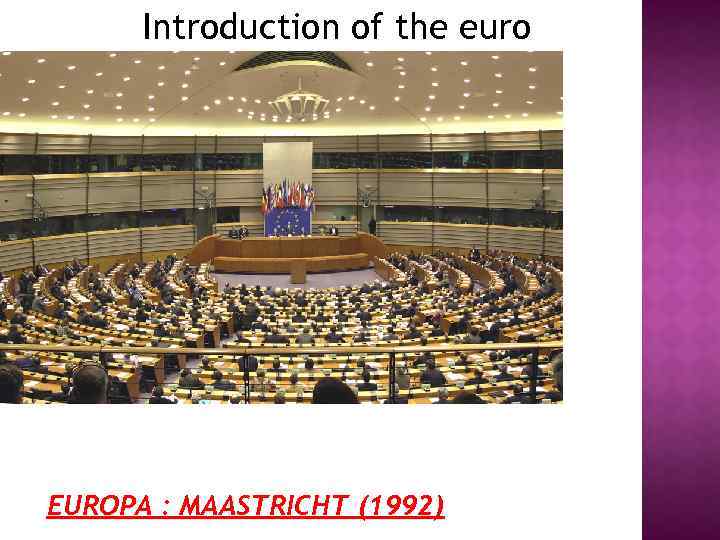 Introduction of the euro EUROPA : MAASTRICHT (1992)
Introduction of the euro EUROPA : MAASTRICHT (1992)
 Economists who helped create or contributed to the euro include
Economists who helped create or contributed to the euro include
 Eurozone The eurozone consists of Austria, Belgium, C yprus, Estonia, Finlan d, France, Germany, Greece, Ireland, Italy, Luxembourg, Malta, the Netherlands, Port ugal, Slovakia, Slove nia, and Spain
Eurozone The eurozone consists of Austria, Belgium, C yprus, Estonia, Finlan d, France, Germany, Greece, Ireland, Italy, Luxembourg, Malta, the Netherlands, Port ugal, Slovakia, Slove nia, and Spain
 Trade balance 2011
Trade balance 2011
 Foreign investment income in billions of euro, 1995 -2010
Foreign investment income in billions of euro, 1995 -2010
 Euro zone inflation from 1991 to 2011
Euro zone inflation from 1991 to 2011
 Creating a European Central Bank, members of European Central Bank and a bit of history The bank was established by the Treaty of Amsterdam in 1998, and is headquartered in Frankfurt, Germany. The current President of the ECB is Mario Draghi, former governor of the Bank of Italy.
Creating a European Central Bank, members of European Central Bank and a bit of history The bank was established by the Treaty of Amsterdam in 1998, and is headquartered in Frankfurt, Germany. The current President of the ECB is Mario Draghi, former governor of the Bank of Italy.
 The primary objective of the European Central Bank is to maintain price stability within the Eurozone ECB has only one primary objective with other objectives subordinate to it.
The primary objective of the European Central Bank is to maintain price stability within the Eurozone ECB has only one primary objective with other objectives subordinate to it.
 The key tasks of the ECB and promote smooth operation of the financial market infrastructure under the Target payments system The monetary policy for the Eurozone
The key tasks of the ECB and promote smooth operation of the financial market infrastructure under the Target payments system The monetary policy for the Eurozone
 Location In 1999 an international architectural competition was launched by the bank to design a new building. It was won by a Vienna-based architectural office named Coop Himmelbau. The building will be approximately 180 metres (591 ft) tall and will be accompanied with other secondary buildings on a landscaped site on the site of the former wholesale market in the eastern part of Frankfurt am Main. The main construction began in October 2008, with completion scheduled during 2014
Location In 1999 an international architectural competition was launched by the bank to design a new building. It was won by a Vienna-based architectural office named Coop Himmelbau. The building will be approximately 180 metres (591 ft) tall and will be accompanied with other secondary buildings on a landscaped site on the site of the former wholesale market in the eastern part of Frankfurt am Main. The main construction began in October 2008, with completion scheduled during 2014
 The euro is divided into 100 cents. The coins are issued in € 2, € 1, 50 c, 20 c, 10 c, 5 c, 2 c, and 1 c denominations.
The euro is divided into 100 cents. The coins are issued in € 2, € 1, 50 c, 20 c, 10 c, 5 c, 2 c, and 1 c denominations.
 All circulating coins have a common side showing the denomination or value, and a map in the background. The coins also have a national side showing an image specifically chosen by the country that issued the coin.
All circulating coins have a common side showing the denomination or value, and a map in the background. The coins also have a national side showing an image specifically chosen by the country that issued the coin.
 The design for the euro banknotes has common designs on both sides. Notes are issued in € 500, € 200, € 100, € 50, € 20, € 10, € 5.
The design for the euro banknotes has common designs on both sides. Notes are issued in € 500, € 200, € 100, € 50, € 20, € 10, € 5.
 The official story of the design history of the euro sign is disputed by Arthur Eisenmenger, a former chief graphic designer for the EEC, who claims to have created it as a generic symbol of Europe.
The official story of the design history of the euro sign is disputed by Arthur Eisenmenger, a former chief graphic designer for the EEC, who claims to have created it as a generic symbol of Europe.
 Inspiration for the € symbol itself came from the Greek epsilon and the first letter of the word Europe, crossed by two parallel lines to ‘certify’ the stability of the euro.
Inspiration for the € symbol itself came from the Greek epsilon and the first letter of the word Europe, crossed by two parallel lines to ‘certify’ the stability of the euro.